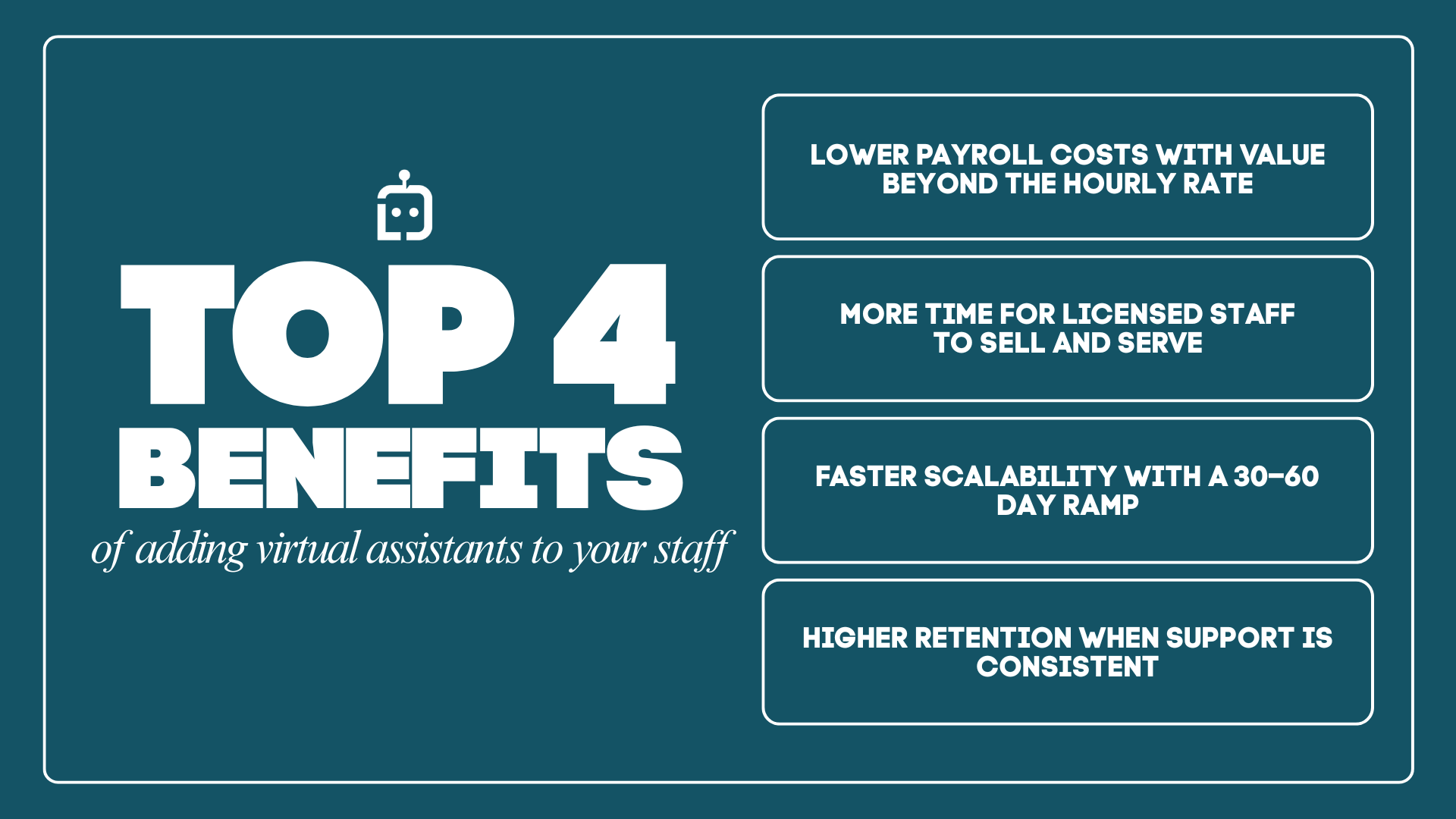Pros and Cons of Virtual Assistants for Insurance Agencies
October 30th, 2025
4 min read

Are certificates, renewals, and data entry eating up your team’s time?
Are you wondering whether a virtual assistant will free you up or create more problems?
You are not alone. Many agency owners wrestle with the same decision. The outcome depends on preparation and the partner you choose.
At Lava Automation, we have partnered with more than 300 agencies nationwide. With billions in premium supported on our systems and thousands of agency hours saved each week, we’ve seen where virtual assistants accelerate growth and where they create frustration if not set up correctly.
In this article, you will learn the biggest benefits and the potential pitfalls of hiring a virtual assistant, so you can decide if this is the right next step for your agency
Top 4 advantages of virtual assistants for insurance agencies
The first advantage most owners notice is cost. Virtual assistants are more affordable than U.S. hires, and strong providers typically include training, compliance, and secure devices in their programs. A U.S.-based employee might cost $50,000 or more per year once salary, benefits, and payroll burden are factored in. A virtual assistant can be a fraction of that cost with no compromise in quality when properly trained.
Virtual assistants also give licensed staff their time back. One agency leader reclaimed 20 hours of producer time per week, which quickly translated into more new premium written. When licensed employees prioritize client service and revenue over administrative tasks, the entire agency moves forward
Scalability is another clear benefit. A properly trained virtual assistant can be productive within 30 to 60 days when you invest in onboarding and coaching. Instead of waiting months to recruit and onboard new staff, agencies can expand their capacity in weeks. That speed often makes the difference between capturing growth and missing opportunities.
Retention adds to the value. Agencies that coach, recognize, and include their assistants see stronger loyalty and avoid costly retraining cycles. In fact, Gallup research shows that engaged employees are significantly more likely to stay, and agencies that extend this mindset to their virtual assistants benefit from the same stability.
Top 4 benefits:
Lower payroll costs with value beyond the hourly rate
More time for licensed staff to sell and serve
Faster scalability with a 30–60 day ramp
Higher retention when support is consistent

Common challenges of hiring virtual assistants (and how to overcome them)
Even experienced agencies face a learning curve when they first bring on a virtual assistant. Most challenges stem from gaps in preparation or communication, not from the assistant’s ability.
Training takes time. Even with prior insurance knowledge, no assistant will know your exact workflows on day one. Planning five to ten hours per week during the first month for guidance and feedback helps them achieve independence more quickly. Agencies that skip this step usually spend more time fixing mistakes later. Structured preparation, such as the phased approach outlined in How Lava Automation Handles Virtual Assistant Training, prevents that problem.
The first month can feel heavier before it feels lighter. Many owners expect instant relief but find themselves answering questions and giving feedback early on. The agencies that stick with the process see a turning point by week six, when their assistant handles renewals and certificates confidently.
Communication needs structure. Misunderstandings happen when instructions are given inconsistently. Agencies that succeed with virtual assistants often use:
Quick daily huddles
Simple process videos for recurring tasks
Team updates for added context
These small routines prevent confusion and keep everyone aligned.
Security must be built in. Relying on freelancers or generalist firms can expose client data without realizing it. Providers that enforce SOC 2 standards, issue secure devices, and monitor logins in real time help eliminate that risk.
Not every role is a fit for outsourcing. Process-driven tasks such as certificates, renewals, and CRM updates are ideal for a virtual assistant. Licensed sales, high-volume phone work, and in-person service are usually better handled by in-house staff. Matching the right responsibilities to the right person sets both sides up for success.
How to weigh the pros and cons for your agency
The first step is readiness. Training is the dividing line between assistants who become growth assets and assistants who create rework. Agencies with clear SOPs tend to see the fastest return, while those starting without documentation should expect more work at the outset.
Compliance should also be heavily considered in the decision. Larger agencies handling significant premium often prioritize oversight and security because one mistake with client records can outweigh any hourly savings. Partnering with a provider that builds compliance safeguards into the program lowers that risk.
Cost still matters, but value is the more important measure. Agencies that only chase the lowest hourly rate often end up paying more in the long run due to turnover and errors. Programs that include training, retention support, and compliance protection create stability and better ROI.
Is a virtual assistant the right next step for your agency?
Hiring a virtual assistant can open new capacity for your team, but only if the right systems are in place. Training, documentation, and structured communication are what turn an assistant from a short-term experiment into a long-term advantage.
If you feel overwhelmed by certificates, renewals, and daily tasks that prevent licensed staff from focusing on clients, you are not alone. Many agencies face similar pressures. Many owners discover that once those tasks are shifted, they finally have space to grow again.
At Lava Automation, we partner with agencies that want more than a low hourly rate. Our assistants are carefully selected, thoroughly trained in insurance-specific processes, and supported with secure systems and ongoing coaching. That combination is what allows agencies to scale with confidence and protect client trust at the same time.
The best way to prepare is to know exactly what to expect. Read: What to Expect When Hiring a Virtual Assistant so you can set clear expectations with your team.
Frequently asked questions
How long before a virtual assistant becomes productive?
Most assistants contribute within 30 to 60 days when supported with training and check-ins. Early responsibilities often include certificates, inbox management, and data entry, with more complex work added gradually.
How much time should we plan to spend on onboarding?
Agencies that invest five to ten hours per week during the first month see the fastest results. That short-term investment creates long-term independence.
Which tasks should we delegate first?
Start with process-driven tasks that are easy to document, such as certificates of insurance, inbox triage, and CRM updates and data entry.
Are virtual assistants secure enough for compliance-sensitive tasks?
Yes, when the provider supplies secure devices, enforces SOC 2 standards, and monitors access. Agencies that skip those safeguards are taking on unnecessary risk.
Will a virtual assistant actually save money?
Yes. Costs are lower than those in the U.S., and when training and retention are factored in, agencies avoid hidden expenses associated with mistakes and turnover. See the full breakdown in What’s the True Cost of a Virtual Assistant?
What if our agency does not have SOPs yet?
Many agencies start without them. Processes can be documented during onboarding, allowing assistants to follow clear steps. Providers like Lava often guide agencies through that process, leaving you with stronger systems than before.
